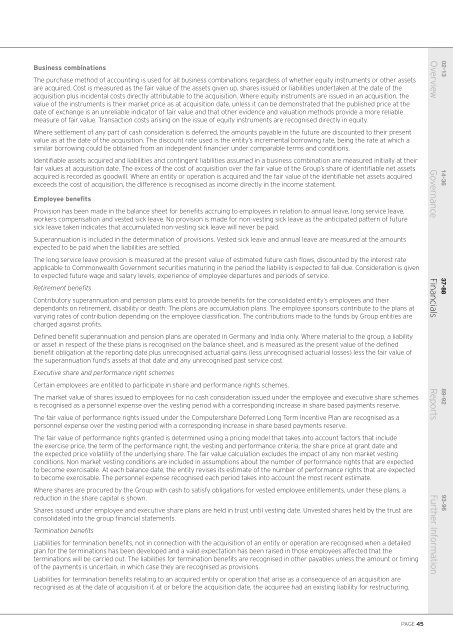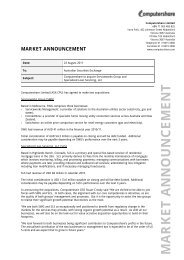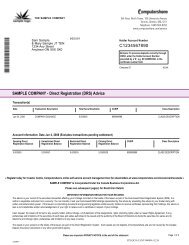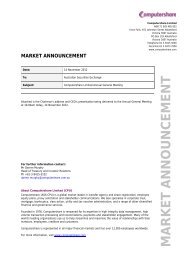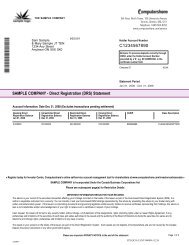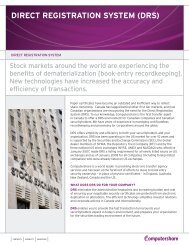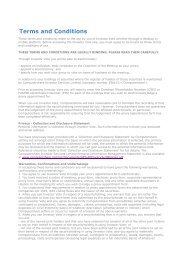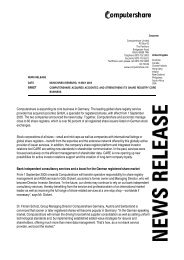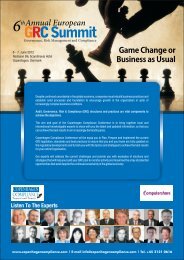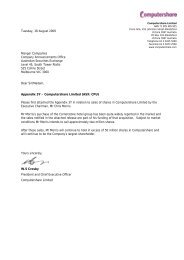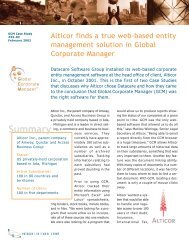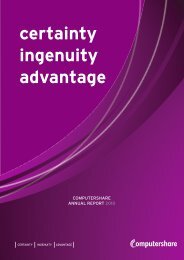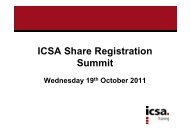COMPUTERSHARE ANNUAL REPORT 2008
COMPUTERSHARE ANNUAL REPORT 2008
COMPUTERSHARE ANNUAL REPORT 2008
You also want an ePaper? Increase the reach of your titles
YUMPU automatically turns print PDFs into web optimized ePapers that Google loves.
Business combinationsThe purchase method of accounting is used for all business combinations regardless of whether equity instruments or other assetsare acquired. Cost is measured as the fair value of the assets given up, shares issued or liabilities undertaken at the date of theacquisition plus incidental costs directly attributable to the acquisition. Where equity instruments are issued in an acquisition, thevalue of the instruments is their market price as at acquisition date, unless it can be demonstrated that the published price at thedate of exchange is an unreliable indicator of fair value and that other evidence and valuation methods provide a more reliablemeasure of fair value. Transaction costs arising on the issue of equity instruments are recognised directly in equity.Where settlement of any part of cash consideration is deferred, the amounts payable in the future are discounted to their presentvalue as at the date of the acquisition. The discount rate used is the entity’s incremental borrowing rate, being the rate at which asimilar borrowing could be obtained from an independent financier under comparable terms and conditions.Identifiable assets acquired and liabilities and contingent liabilities assumed in a business combination are measured initially at theirfair values at acquisition date. The excess of the cost of acquisition over the fair value of the Group’s share of identifiable net assetsacquired is recorded as goodwill. Where an entity or operation is acquired and the fair value of the identifiable net assets acquiredexceeds the cost of acquisition, the difference is recognised as income directly in the income statement.Employee benefitsProvision has been made in the balance sheet for benefits accruing to employees in relation to annual leave, long service leave,workers compensation and vested sick leave. No provision is made for non-vesting sick leave as the anticipated pattern of futuresick leave taken indicates that accumulated non-vesting sick leave will never be paid.Superannuation is included in the determination of provisions. Vested sick leave and annual leave are measured at the amountsexpected to be paid when the liabilities are settled.The long service leave provision is measured at the present value of estimated future cash flows, discounted by the interest rateapplicable to Commonwealth Government securities maturing in the period the liability is expected to fall due. Consideration is givento expected future wage and salary levels, experience of employee departures and periods of service.Retirement benefitsContributory superannuation and pension plans exist to provide benefits for the consolidated entity’s employees and theirdependants on retirement, disability or death. The plans are accumulation plans. The employee sponsors contribute to the plans atvarying rates of contribution depending on the employee classification. The contributions made to the funds by Group entities arecharged against profits.Defined benefit superannuation and pension plans are operated in Germany and India only. Where material to the group, a liabilityor asset in respect of the these plans is recognised on the balance sheet, and is measured as the present value of the definedbenefit obligation at the reporting date plus unrecognised actuarial gains (less unrecognised actuarial losses) less the fair value ofthe superannuation fund’s assets at that date and any unrecognised past service cost.Executive share and performance right schemesCertain employees are entitled to participate in share and performance rights schemes.The market value of shares issued to employees for no cash consideration issued under the employee and executive share schemesis recognised as a personnel expense over the vesting period with a corresponding increase in share based payments reserve.The fair value of performance rights issued under the Computershare Deferred Long Term Incentive Plan are recognised as apersonnel expense over the vesting period with a corresponding increase in share based payments reserve.The fair value of performance rights granted is determined using a pricing model that takes into account factors that includethe exercise price, the term of the performance right, the vesting and performance criteria, the share price at grant date andthe expected price volatility of the underlying share. The fair value calculation excludes the impact of any non market vestingconditions. Non market vesting conditions are included in assumptions about the number of performance rights that are expectedto become exercisable. At each balance date, the entity revises its estimate of the number of performance rights that are expectedto become exercisable. The personnel expense recognised each period takes into account the most recent estimate.Where shares are procured by the Group with cash to satisfy obligations for vested employee entitlements, under these plans, areduction in the share capital is shown.Shares issued under employee and executive share plans are held in trust until vesting date. Unvested shares held by the trust areconsolidated into the group financial statements.Termination benefitsLiabilities for termination benefits, not in connection with the acquisition of an entity or operation are recognised when a detailedplan for the terminations has been developed and a valid expectation has been raised in those employees affected that theterminations will be carried out. The liabilities for termination benefits are recognised in other payables unless the amount or timingof the payments is uncertain, in which case they are recognised as provisions.Liabilities for termination benefits relating to an acquired entity or operation that arise as a consequence of an acquisition arerecognised as at the date of acquisition if, at or before the acquisition date, the acquiree had an existing liability for restructuring.02-13Overview14-36Governance37-88Financials89-92Reports93-96Further InformationPAGE 45


